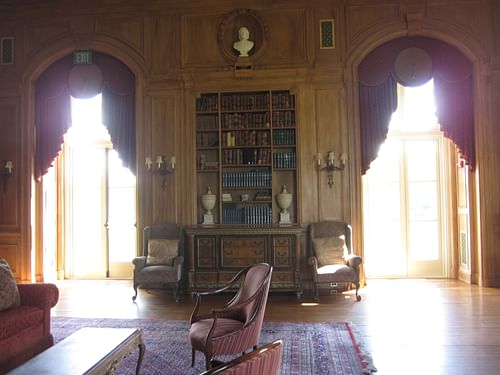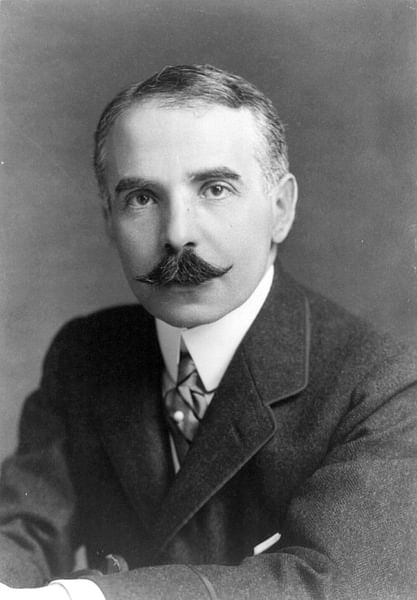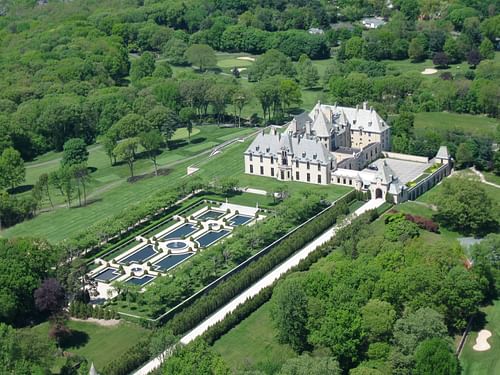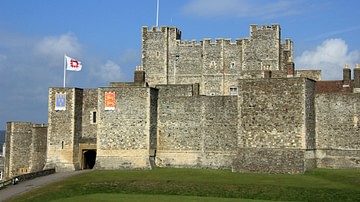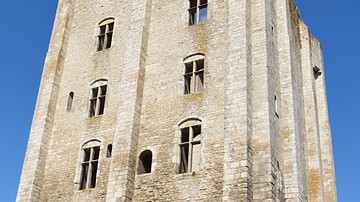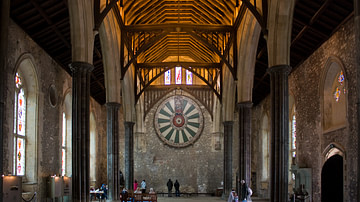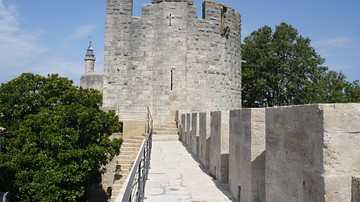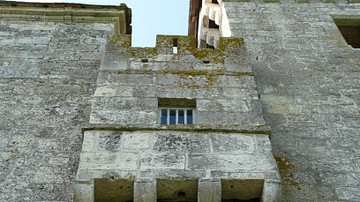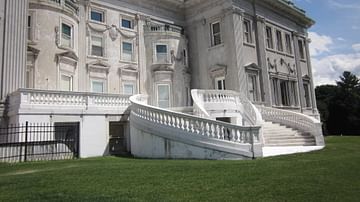Oheka Castle, built by the industrialist Otto Herman Kahn (l. 1867-1934), is one of the best-known luxury hotels of Long Island, NY, USA today. In its time as a private residence, it was the site of the kind of lavish parties which inspired the F. Scott Fitzgerald novel The Great Gatsby and continues to offer that same experience.
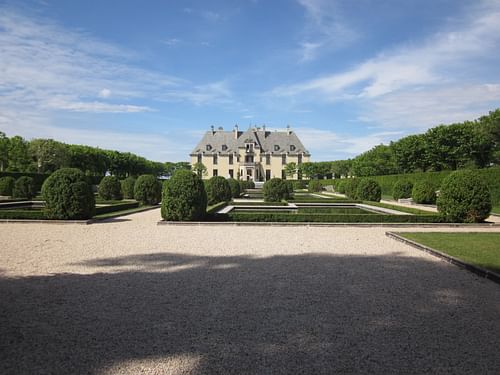
You step into the immense expanse of the foyer and there's the Grand Staircase ahead, wrought iron railings gracefully curving up from the stone landing on which fresh flowers rest on a marble altar. Your footsteps echo loudly across the stone floor and again up the steps to the second floor where a long carpet-runner muffles them as you pass by paintings of various sizes on the walls and statuary on pedestals, all quietly bathed in soft golden light.
Halfway down the hall, you open the door on your left and walk into a room ornately decorated with a silk embroidered couch beneath a gilt-edged mirror, flowers in a vase on a marble pedestal. Sunlight streams in through the window on the far wall and you move past the receiving vestibule with the couch to the bedroom area, draw back the drapes, and look down upon the manicured gardens and fountains. Off beyond the gardens you see Long Island Sound, and, in the silence, you can hear the deep booming of the ship’s engines and the long, low bellow of a tug's horn.
If you feel yourself a character in The Great Gatsby, well, you are not far off. Fitzgerald's novel is set on the so-called Gold Coast of America in the 1920s - the area of Long Island, NY where the wealthy elite built their summer homes between c. 1900 and 1920. Many of the most famous names - Vanderbilt, Phipps, Woolworth - had grand estates here and some have been preserved and are open to the public for tours. The one you have walked into is different from the rest in a number of ways, however, and, most notably, you can stay there. You are in Oheka Castle, formerly the home of investment banker and philanthropist Otto Herman Kahn which, today, is a luxury hotel in Huntington.
Time Travel to the 1920s
Although famously known as a "castle" the building is actually an early 20th-century French-style Chateau designed by the famous Olmstead Brothers Firm (which included Frederic Law Olmstead, the architect who designed New York City's Central Park) who also planned the intricate lawns and gardens. Originally an estate of 433 acres, the site is now comprised of only 23, most of it a golf course, though the French gardens and much of the statuary of the original estate remains.
A weekend at Oheka Castle is time travel back to the 1920s. The owner, Gary Melius, has carefully renovated and preserved the building to reflect the interests and tastes of the original owner. Vintage artwork hangs on the walls and one passes by statues and busts of Socrates, Plato, Epictetus, and Epicurus in the second-floor hallway. Walking down the winding back staircase from the second floor to the bar you feel like Gatsby about to throw another of his famous parties. The wood-paneled library, shelves lined with volumes, looks out through floor-to-ceiling French doors onto the gardens and the lawn and you cannot shake the feeling that Hemingway or Gertrude Stein or T.S. Eliot could stroll into the room any moment.
We were there for a wedding for which we would be staying the weekend and arrived on a Friday. Guests are encouraged to enter through the main gate though one can also access the grounds through a back road. A gatekeeper radios one's arrival and opens the gates. The drive up to the parking lot is impressive enough, passing manicured hedges, statues, carefully cultivated ivy on the archway, but once you pull in to the spacious parking lot, the impression of the hotel is stunning. Oheka is a commanding presence and even before you set foot inside you understand you are experiencing something exceptional.
On this trip, as on most, my wife Betsy and daughter Emily were along, and we all experienced the same sensation of stepping back in time as soon as the high wooden front doors were opened for us and we set foot in the foyer. The lighting from an opulent chandelier high overhead and wall sconces illuminates the grand hall in a soft blush of gold as from candles or oil lamps.
After checking in at the small office just inside the door, we were directed to our room on the second floor and took the ancient elevator up. It should be kept in mind that one is staying in a vintage hotel and the elevator will not operate at maximum 21st-century speed. Remember, you have stepped back in time; everything moved a little more slowly in the 1920s. The elevator opened on the long hallway decorated with artwork and sculpture under soft lighting, noted above.
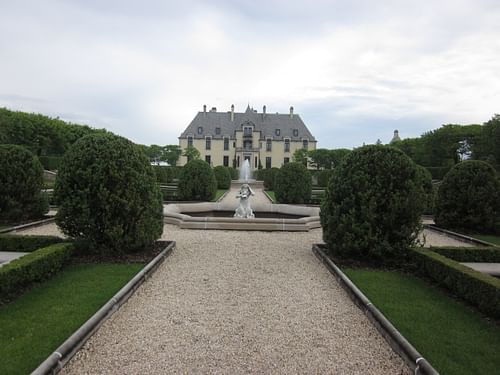
Our room, previously described, was spacious with bathroom en suite complete with a vintage claw-foot tub and modern shower. There is a television and telephone in the room, neither of which we used, and WIFI is available and password-protected for guests. Modern amenities are never our priority when travelling, however, as we always opt for the time-travel experience in full when we can. Gazing out the window of our room down at the intricate gardens, fountains, and statues under the high blue canopy of a June sky, I thought of the original owner and the people of the past who had stood where I was standing.
Kahn's Dream: Oheka Castle
This magnificent home was once the private residence of one of New York City's most successful bankers. Like many of New York's elite in the late 19th and early 20th centuries, Otto Kahn spent a considerable amount (an estimated $11 million, equal to $110 million in the present) to buy this land and build his estate along the prestigious North Shore of Long Island Sound. In the same way as many others, Kahn wanted his home and gardens to impress but his motivation was quite different; Kahn was Jewish in a society which looked down on Jews. He wanted his home and grounds in Huntington to prove he was the equal of any of the New York elite who scorned him, and he succeeded.
Oheka Castle was built between 1914-1919 somewhat later than most of the great mansions of Northeast America. The name is an acronym of Otto Hermann Kahn. Many of the very rich of the Gilded Age, as noted, built lavish estates on Long Island and if Oheka was just one more - albeit open as a hotel - it would perhaps be worth only a passing mention. The Vanderbilt estate, after all, is much more lavish with a more impressive vista. It is the story behind Oheka and how one man refused to be brushed aside and ignored which makes the site so interesting.
Otto Hermann Kahn was a Jewish banker at a time in America when being a Jew meant being excluded. In the late 19th and for most of the 20th century Jews were regularly excluded from country clubs, resorts, and the best hotels. The 1947 film Gentleman's Agreement, based on the Laura Z. Hobson novel and starring Gregory Peck, exposed the hypocrisy of American society in claiming to be the land of the free and of equal opportunity while actually only offering equality and freedom to White Anglo-Saxon Protestants of means.
The film producers were worried about making the movie in 1947 because they felt it might stir up problems for the Jews. Peck's agent told him to pass on the part of a gentile journalist who poses as a Jew to expose the inherent antisemitism of American society because he felt it would ruin Peck's career. The fact that these were considerations as late in the century as 1947 shows how deeply antisemitism had become a part of American society and how prevalent it was mid-century; it was much worse earlier.
Kahn was born in Mannheim, Germany in 1867, one of eight children, and wanted to be a musician. He mastered a number of instruments in his youth but was prohibited from pursuing a musical career by his father who had decided the boy should become a banker. At the age of 17, Kahn began work in a bank as a junior clerk and learned the business from the ground up. His financial talents were so impressive that he was hired by a branch in London where he quickly rose to the top and was then invited in 1893 to join the prestigious banking firm Speyer and Company in New York; he was 26 years old.
Displaying the same brilliance for finance he'd shown since youth, Kahn became as successful in America as he had been in England. He married the young socialite Addie Wolff in 1896 and went to work for her father's firm of Kuhn, Loeb, & Co. Kahn's success was completely self-made, and he was welcomed into the firm warmly as a great asset. As he continued on in his career he became even more well-known and more wealthy as he reorganized the Union Pacific Railroad and went on to become associated with brilliant strategies in organizing and restructuring other railroads throughout the United States.
As one of the most successful industrialists of the age, Kahn should have been welcomed in the most select circles of high society, but this was not to be. Antisemitism was so prevalent that Kahn felt uncomfortable in his city apartments and his country home of Morristown, New Jersey. He hoped that things might get better for him and his family on Long Island and so purchased 443 acres in Huntington and commenced building his grand estate in the middle of it.
Now, you would think that if your neighbor is wealthy enough to buy 443 acres of land and build a castle with Versailles-style sunken gardens and reflecting pools maybe it would be a pleasant experience to get to know him, invite him over for tea or tennis, toss him an invitation to the country club; but none of these possibilities occurred to the members of high society of Huntington, Long Island at the time. Kahn was a Jew, and they did not want a Jew as a neighbor, much less a member of their country club. He was a great patron of the arts, financed Hollywood film projects, donated liberally to charities, and commissioned grand building projects but none of this moved those he hoped to impress.
Recognizing that his success meant nothing to the antisemitic community which surrounded him, Kahn redirected his energies to create one of the most elaborate and opulent private homes in the nation. He made his country estate so lavish that it remains to this day the second-largest private dwelling in the history of the United States (after George Vanderbilt's Biltmore mansion in North Carolina). The French-style chateau was 109,000 square feet (c. 10,000 m²) with 127 rooms, an indoor swimming pool, stables, orchards, tennis courts, one of the largest greenhouse complexes in the United States, and even a private landing strip for planes. Since he was denied access to the club and adjoining golf course, he decided to build his own: an 18-hole, state-of-the-art course designed by the golf architect Seth Raynor. If the elite of Huntington would not let Kahn play on their golf course, he would play on his own.
And once he was done with his ambitious building and landscaping plans? The elite of Huntington came to him to ask if they could play on his 18-hole course which turned out to be much nicer than their own; they also invited him to join their country club.
As far as anyone can tell from the records, Kahn never publicly criticized these people for their enormous stupidity and prejudice. He was told he was unwanted very clearly but, instead of submitting to the bullying and accepting it, he forced the bullies to accept him. It is unlikely the wealthy elitists of Huntington ever actually accepted Kahn as an equal and more than probable they talked behind his back all the time, but Kahn got what he wanted from the society of the day: respect. Of all the financiers and industrialists of the time, Kahn is the only one universally recognized today - even if most people do not realize it; he is the model for the banker-persona image of the popular Monopoly board game and Oheka Castle appears in the opening montage of the classic 1941 film Citizen Kane.
Later History
After Kahn's death in 1934, Oheka suffered the same fate and followed the same course as many of the grand Gilded Age homes: his heirs had neither the interest nor the resources to maintain it, and the chateau changed hands a number of times, finally housing the Eastern Military Academy in 1948. By this time most of the acreage had been sold off and the golf course absorbed by the very country club which had at first denied Kahn membership.
The Academy, which subdivided the rooms to accommodate more students and leveled most of the gardens, held the estate until 1979 when it closed, and Oheka began to deteriorate. Vacant and forgotten, it was subject to a number of arson attempts and vandalism until 1984 when developer Gary Melius bought the property and began restoration to transform Oheka into a luxury hotel.
His $30 million effort included meticulous recreation and restoration of the original Kahn estate down to the smallest details in architrave and ornamentation throughout the house. Oheka is a popular choice for television and magazine photoshoots, has been featured in documentaries and music videos, and routinely hosts high-end weddings throughout the year. It was just such a wedding which brought us to the castle, and the celebration was a grand affair, which would have made Kahn proud.
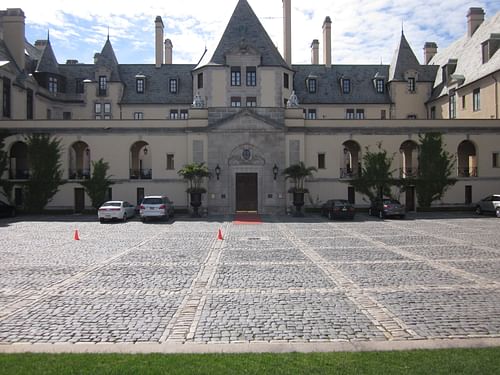
After the wedding ceremony, which was held out in the gardens toward twilight, the reception went on all evening. Standing outside on the lawn by the garden stairs, I looked up at the glowing windows of the house. Oheka was brightly illuminated from within with every lamp burning and the sounds of laughter and music. Guests came out through the library's French doors, drinks in hand, to smoke and talk on the lawn, and, far off from Long Island Sound, came the distant thrumming of the ships in the dark.
I first read The Great Gatsby when I was 20 and dreamed of what it must have been like attending one of Jay Gatsby's lavish parties in 1920s Long Island; that evening I felt as though I were there, back in time, right down to the formal wear of the guests laughing, talking, and drinking on the wide lawn beneath the towering mansion. Kahn built his estate to be impressive but also wanted it to be a refuge from the outside world where he and his family could feel safe and enjoy themselves. He realized his dream during his life and, thanks to the vision of the present owner, Kahn's opulent home is open to those in the present day to realize a few dreams of their own.
